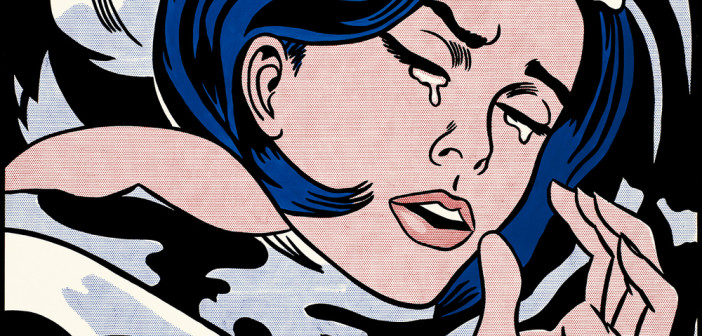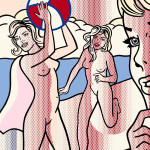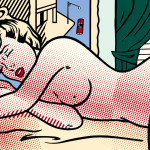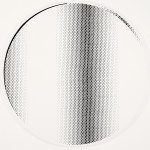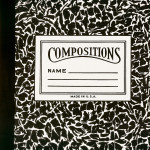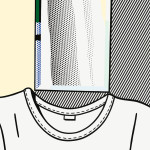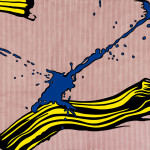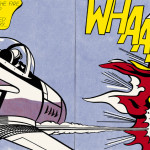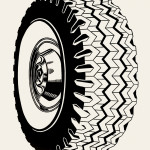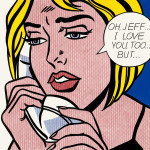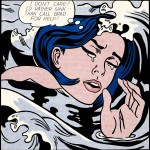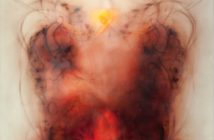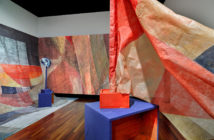Conjuring the familiar folktale of a thirty-eight-year-old Roy Lichtenstein heading over the bridge to Manhattan with five canvases strapped to the top of his station wagon sometime in 1961 is nearly impossible amid the sprawling grandeur of Washington, D.C. and the opulence of the National Gallery of Art, host to the most recent leg of the artist’s touring retrospective. But we owe it to him to try, as comprehending the weight of his contribution to the larger ideas of Twentieth Century Art requires a trip backward to the world of pre-Lichtenstein. Besides, what singular lesson about art and life did this preeminent Pop artist teach us, if not the permeating importance of context? Take his most iconic works for example, those like Drowning Girl from 1963. These paintings rely on appropriation—a universal understanding of their pedigree—in order to operate beyond decoration as they enter the realm of masterpiece. This trope of a comic book square enlarged, altered, rendered, and placed in a gallery or museum is central to the comment on society and life; the contempt, dark satire, and humor inherent in all of Lichtenstein’s work. So while the Smithsonian, the Capitol, the White House, and the Washington Monument flank the National Gallery, and attempt to set the tone for this trip through Lichtenstein’s career, these symbols—these clearest emblems of establishment our country has—must be momentarily disregarded to capture the importance of his work. There is this challenge of context at the outset when taking in Roy Lichtenstein: A Retrospective at the NGA, for recognizing the ’61 Roy Lichtenstein as anything but a part of the mainstream is essential when trying to grasp the monumental impact of his work in the canon of American Art.
But beyond the architectural, there are complications when presenting the career of an extraordinarily prolific, and markedly guarded, art world legend. Generally retrospectives promise a glimpse of the inner spirit of an artist, secrets only obvious once their work is gathered in the same space. But the 100-plus artworks on display at the National Gallery battle against Lichtenstein’s project to remove himself nearly entirely from expression, or at least from personal expression. His goal to render subject without the telltale emotions of artist is by no means a new one, as artists have been commissioned throughout history to advance personalities, causes, and beliefs while subverting their own person, but Lichtenstein stands out as revolutionary as he succeeds in creating an image of his audience reflected through these subjects, rather than the other way around. His paintings act as mirrors. While we can see pieces of the man in his craftsmanship, approach, and subversion; his ability to present an accurate, unwavering portrayal of the collective culture, and of the individual’s relationship to it, often is so powerful it shields a greater understanding of Lichtenstein himself.
In context: An uncertain and hopeful young art instructor looking for a break showed up at Leo Castelli’s gallery on East Seventy-Seventh Street in 1961, only to be catapulted into superstardom after a sellout solo show mere months later.
The Museum of Modern Art, New York, Philip Johnson Fund (by exchange) and Gift of Mr. and Mrs. Bagley Wright, 1971
© Estate of Roy Lichtenstein
Lichtenstein’s station wagon traveling over the Hudson to destiny was a pre-Pop car ride, Warhol and Rosenquist sequestered to other corners of Manhattan, experimenting with appropriation and form on their own; Jasper Johns and Robert Rauschenberg successful in straddling the tightrope between expression and collage, were on the verge of something else. This was the New York City navigation of an underdog, a concept nearly impossible to grasp in the hallowed halls of the National Gallery of Art as it plays host to Lichtenstein’s first major retrospective in nineteen years, and the first since his death. That journey to Leo Castelli’s gallery, now multiplied by fifty-ish years of mythos and success, was that of an artist attempting to set the art world on its side; an art world that now embraces Roy Lichtenstein as a modern master, a king of Pop, a financial success, and the subject of this retrospective.
In context: Back in 1961 when Roy Lichtenstein was searching for a parking spot, the closest the National Gallery came to avant-garde American Art in its special exhibitions was a retrospective of the Realist Thomas Eakins, who was then dead nearly fifty years; an artist who had studied art in Europe and propagated those teachings throughout his career. Chinese art, European art, King Tut, Goya, Rembrandt, and Eyewitness Etchings from the Civil War were the other offerings from the museum that year.
Further, as the National Gallery is the exhibition’s second stop on a three-city tour (four if you count the final, smaller version slated for Paris), the show’s premier host, the Art Institute of Chicago, recently announced that Roy Lichtenstein: A Retrospective had over 300,000 visitors during its three-and-a-half month run there, making it the most-attended exhibition the museum has hosted in the past ten years. But the decadence of the NGA isn’t the only mark of revolutionary change in the art world’s orbit as it circles around Roy Lichtenstein. In May of this year Lichtenstein’s Sleeping Girl, 1964 broke the artist’s auction record, with a gavel drop of nearly $45 million at Sotheby’s.
In context: The comic book, Girls’ Romances #105 issued by DC Comics in 1950—the one Lichtenstein appropriated the image of Sleeping Girl from—originally sold for twelve cents at the newsstand.
Thus, Lichtenstein is an artist still propelling past the heights of his enduring success, now necessarily plopped down in a different context altogether. And since context is so important in this regard, with the back-and-forth careening between the world of his artistic beginnings and the world of his enduring artistic legacy since his death, how does the artist hold up in retrospect? For how can anyone endure their artwork being appropriated by the cultural elite, removed from the top of a station wagon, and placed in the National Gallery or on the auction block at Sotheby’s, when subverting the mainstream and casting light on the distorted ideals of post-war America is at the core of their art? The show’s organizers do well to peel back the curtain on Lichtenstein the man with a detailed chronology of his life and work included in the exhibition catalogue, and this acts to dispel certain myths. But their ability to present a more robust image is hampered by his ever-present desire to remain behind the screen. Take his Self Portrait, 1978 as an example of the near-impossibility of their task. Roy Lichtenstein was never attempting to reveal more of himself to us through his art. Instead, Lichtenstein was succeeding at revealing more of ourselves to us, seemingly through the least intimate of means.
POP STARTS Beyond the majesty of our nation’s capital, there is the over-the-top decadence of Roy Lichtenstein at his beginning. At the outset of this expansive exhibition, we’re confronted with the Lichtenstein’s Lichtenstein, the Art History survey materials, the images from the first sellout shows at Leo Castelli’s, the springboards to early and permanent greatness.
Collection Simonyi
© Estate of Roy Lichtenstein
And they are different in person; it’s true. One of the central hinges of irony in the oeuvre of Lichtenstein is that his reproductions of the mass-produced must be seen in person to be comprehended. There is a different quality of color, of composition, of space, of contrast, that cannot be reduced and understood inside the Art History textbook du jour. Here, hanging together, his first album is already a greatest hits record. Forget the nostalgia of what these stand-ins for society’s simplest emotions represent (something that has enduring lure for his enormous following), as there is a more remarkable nostalgia for a moment of expression, philosophy, and vision possible in American art that collided in these works. Any lingering resentment over his meteoric rise to success is forgiven immediately upon contemplation of these efforts, as it was so clearly deserved. Seeing Drowning Girl, 1963, Compositions I, 1964, or Whaam!, from 1963 in person.
For reference, Harry Cooper’s essay "On The Dot," deconstructing the painting Look Mickey, 1961, Lichtenstein’s first foray into his signature style, is worth the price of the exhibition catalogue alone. He points us to an aspiring artist—an aspiring American artist (a relatively new concept)—adept at figurative styles, steeped in abstraction, bashfully presenting the surreal state of affairs of post-war America. While Pollock, Gorky, Rothko, and Kline may have produced the turmoil, doubt, and suffering of the edge of World War II (and even the ascent to victory) and while Jasper Johns and Rauschenberg may have merged this expressionism with a Dada notion of appropriation and conglomeration, Roy Lichtenstein found his home in the prefabricated suburban sprawl of a scratching-its-head-America, a what-is-it-all-about-America, a newsprint smear of empty promises and fresh anxious headlines in the morning.
Roy Lichtenstein drove over that bridge en route from suburban New Brunswick, New Jersey to urban Manhattan amid the realities of 1961 America, something inescapable when confronting nearly all of the pictures included here. There was a newly elected JFK, the first Intercontinental Ballistic Missile tests, the first man in space (Russian), Adolf Eichmann’s Nazi War Crimes Trial in Jerusalem, the second man in space (American), Freedom Riders and the Civil Rights Movement, The Bay of Pigs. JFK was urging civilians to build fallout shelters; the construction of the Berlin Wall commenced. The promise and consumption of a victorious America, savior of the free world during World War II, had become an anxious weight as the Cold War escalated into suburbia. The world hadn’t only changed from the promise of free expression in the hands of the Abstract Expressionists, when the shifting center of the art world from Paris to New York; in 1961 the technology that had promised utopia now seemed poised to deliver apocalypse.
While Lichtenstein has often been criticized as an apolitical artist, this fallacy is revealed in the first works of the show. Combined with the biographical information on Lichtenstein’s relationship with Allan Kaprow—the absurdist master of the Happening—and the dispelling of the myths that Lichtenstein arrived wide-eyed, unannounced and unprompted on East Seventy-Seventh Street, and Lichtenstein’s works are anything but neutral. They become Kaprow-ish "Happenings" in their own regard—obvious attacks on the establishment.
For some background on the dynamics of state-sponsored art during the Cold War, Eva Cockroft’s June 1974 ArtForum piece "Abstract Expressionism: Weapon of the Cold War," lays out the basics of the stylistic differences dictating propaganda methods for the major world players. In short, Abstract Expressionism, with its sweeping brushstrokes, personal expression, and excess, was a perfect foil for Soviet Social Realism, and a tool with which to advance the pedagogy of democracy. However, in the rising tide of post-war disillusionment, and the entry point for Pop Art, Lichtenstein’s work subverts this style, casts a wary eye toward capitalism and its culture. If anything, his rigor, control, and honor of traditional representation seems more in line with the opposition to American Expressionism than the next logical point of progression on an Art History timeline.
Beyond the obvious comment on gender roles and soap opera culture of paintings like Oh, Jeff . . . I Love You, Too . . . But . . . from 1964, and the elevation of the dramatic and absurd as ideals for romance in these paintings, Lichtenstein’s early works also render his audience—the American public—within the confines of his style. If Jackson Pollock was somehow unwittingly celebrating American freedom by dribbling paint on canvas, Lichtenstein was lamenting the conformity, confinement, and trappings of tract housing, assembly-line automobiles, and mass-produced culture with his identical and repetitive dots, more in line with Soviet Realism than with the work of his American predecessors.
The Doris and Donald Fisher Collection, San Francisco, and the Museum of Modern Art, New York
© Estate of Roy Lichtenstein
These dots, these stand-ins for consumers unthinkingly standing at attention for the commands of the latest advertisement, are further confined by the dark lines throughout each work, sequestering them. This confinement is heightened by the composition strategies of each early Lichtenstein: women pressed to the edges of the canvas, military men caught beneath the canopy of attack fighters, lovers entangled and tied up in each other’s arms, narrators tortured by the encroaching weight of their words in mushroom-cloud thought balloons and dialogue boxes pressing down at their flesh. In fact, the draconian task of applying these dots, which Lichtenstein did at first with the assistance of a stencil and a toothbrush, is another comment on the failed promise of consumerism and the irrelevance of previous art; a process more akin to Chinese children toiling in their assembly of iPads, rather than the romantic dance around canvas made famous by the AbExers. But once Lichtenstein adds in the bright primary colors of a children’s Crayola box, and the darkly comedic appropriation of comic book squares, he’s able to deliver the harshest news of a failed Shangri La with the satire of a Kurt Vonnegut. We laugh at ourselves for believing the myths, even as fighter jets brat-tat-tat across the sky. In fact, one of the greater virtues of this retrospective is the out-loud laughter these complex images can inspire.
Lichtenstein excels in the implicit approach found in his early works. The tongue-in-cheek quality to these pictures reveal a man with more to say, a man who shares a grin and a nod with his audience, even as he operates behind the scenes. While his later forays into claiming subject matter directly from the world of art seemed to both question his place in history, while simultaneously asserting it, paintings like Compositions I, 1964 successfully undermined the status quo with a different strategy. This work, which is impressive in person given its scale and contrast of black and white, is on par with Robert Rauschenberg’s Erased De Kooning Drawing, 1953 for its successful takedown of Abstract Expressionism. The courage of this work is often underestimated, as Lichtenstein was an adept expressionist who would be haunted by his artistic forebear’s gestural brushstroke as an unrecoverable emblem for his entire career afterward. And if the AbExers do, in fact, present the first wave of true avant-garde work to originate in the USA, the decision of Lichtenstein to undermine it directly was no small matter. Placed next to a prototypical Jackson Pollock, like Number 1, 1950 (Lavender Mist), and Lichtenstein’s Compositions I is able to point out the flaws, the trappings, the repetitive nature of all-over painting, with the subtle genius of a schoolboy’s symbol appropriated, and one of the most exacting uses of text to date in contemporary art. There is a fearless quality to these pictures that seek to undercut the American art scene, and they remain daring to this day. Further, one should recognize the ingenuity in all of Lichtenstein’s early work in the use of both text and images. While other artists had collaborated with writers, or employed the forms and symbols of words and numbers in their pictures (see Jasper Johns and Rauschenberg), Lichtenstein is arguably the contemporary founder of utilizing textual devices as a direct partner in visual art; a trend that has exploded in recent years, and also speaks to the mixed-media "Happening" quality of his work. But the ability to reduce Pollock to an academic painting, a composition lesson, remains as one of the more aggressive undoings in post-War art.
In case anyone mistook Rauschenberg’s erasure as the final note in artistic subversion, Tire, 1962, provides another example of both appropriation and the direct assault on art Lichtenstein performed early on in his career. Rather than the stolen hubcap of real world appropriation, we are presented with a singular, isolated tire, surrounded by the white vacuum of space, without horizon or gravity. This space-age product, with all-weather radials and traction-controlled tread, questions the ability of the individual to act on his/her own when making a decision, as we are offered an example of advertising imagery. But beyond the illusion of choice, we have an individual unable to act on his/her own; in terms of function, too, as the form of the tire can’t operate in isolation. Without its three brethren the tire is a meaningless promise. It mimics the shape and isolation of those Lichtenstein Ben Day dots when seen separately as well; a circle on a field of white, a further stand-in for the lack of individuality in post-war culture and Madison Avenue occupation, individuals whose voice is anything but expressive, but collected by product placement and consumer culture, stagnant and unwavering. This platform points back at Robert Rauschenberg, too, who had used a tire (affixed to a car and driven by John Cage) to paint a picture on twenty sheets of paper with Automobile Tire Print of 1953, by driving down the pages. In this respect, one can ask if Lichtenstein is presenting a picture of masculine identity, false advertising, isolation, or a comment on Rauschenberg’s notion of a contemporary paintbrush. In response to a picture of tire tread on wall, Lichtenstein brings us back to the source; the circle, the dot found in the origins of his work, and a clean non-expressive version of the American symbol of freedom—tire smears down the open road. The power of these early works advance Lichtenstein’s questions about American individuality while steering art in another direction, and symbolizing his art audiences with objects of everyday life as their looking glass. In his capable hands, there can be just as much power in a controlled rendering of a tire, as in an expressive streak of paint pressed against the street. There can be even more power in a stark black-and-white image, as with Compositions I as well as Tire, as with the splashes and smears of Pollock or Rauschenberg. But anyone who doubts the impact these attacks had on Lichtenstein, the man, need only consider the albatross-like brushstroke motif, which repeats again and again over the course of his career, as with Brushstroke with Splatter, 1966. While he may have necessarily pushed art in another direction, subverting the work of his predecessors as he did so, Lichtenstein’s longing for release, for personal expression—for the comfort of his forbears—repeats in these nearly remorseful returns to a simpler era of connection to craft, to paint, and to audience; a relentless returning to the artists who came before.
ART HISTORY If there is a penance to be paid by Roy Lichtenstein for dismantling the American art that came before—beyond his coveted returns to rendering a brushstroke—his appropriation of the masterworks of art history prove a challenge in this exhibition. The initial skirmishes with art and artists discussed above, by the art teacher Lichtenstein, are somehow more effective at the NGA than the direct art historical pieces which follow, perhaps because of their contradictions and complexities, or in subtleties lacking. Progressing to his next steps, as he embarked on appropriating iconic images from the canon of art history, one can feel Lichtenstein casting aside the hide-and-seek questions posed by his audience at the time. Tailored to a newfound ravenous collectorship, a gallery/museum audience who understood the context of these art historical pictures immediately, Roy Lichtenstein turned to rendering the work of Matisse, Van Gogh, Monet, and Picasso with his signature method of limited color palette, dot and line, as a strategy to remove any questions of source material, to remove any distractions. Here the challenges of organizing a retrospective might be most apparent, as with the mass of objects organized, the result casts Lichtenstein into a sort of spastic partygoer inserting himself mercilessly into every conversation in the room. Also, these paintings are some of the artist’s least intimate and overtly intellectual efforts—at least when collected en masse. While there are treats on display, like his riff on De Kooning’s Woman III, 1982, or his version of Matisse’s goldfish, and while many reveal Lichtenstein’s longing for the expressive nature of the unrestrained line, the miniature Lichtenstein museum within the NGA (which is what these art history galleries feel like) pushes the limits of suspending context required when taking in the artist. And at first, they do seem like an overt attempt by Lichtenstein for inclusion in the greater dialogue of art history, but eventually they respond in a similar manner to the famous comic-book panels. By questioning the subject the audience is continually looking at, and elevating in importance and symbolism—in this case, art history—Lichtenstein’s works continue to hold a mirror up to each of us, a question of our values and sensibilities.
The Art Institute of Chicago, Barbara Neff Smith and Solomon Byron Smith Purchase Fund
© Estate of Roy Lichtenstein
However, I couldn’t help feel that these pictures operate best in smaller doses. I was lucky enough to take in the Monet/Lichtenstein Rouen Cathedrals exhibition at the Museum of Fine Arts in Boston in 2011, and in that environment there was a sense of intimacy between the two artists, a conversation, and a reverence to contemplate. In a retrospective that already wrestles with intimacy, these art history rooms become the most stand-offish, guarded, and questioning; just as Lichtenstein may have been questioning his sudden and unexpected success at the time. But organized as they are, these works propel the viewer back toward the originals, rather than remain in consideration of Lichtenstein. They create distraction rather than limit it. Although there are moments when, in the haystack paintings for example, Lichtenstein’s use of dots becomes more expressive, considerate of color, and ephemeral—the only instances where his technique actually nears Seurat’s pointillism—these paintings mostly become engulfed by the art they attempt to address. Finally, I was surprised and a bit disappointed that none of the riffs on Monet’s Water Lilies had made it to the exhibition, which of course contradicts the notion that the show includes too many of the art history series.
NUDES Barbie-doll types stripped of sexuality, embedded in odd situations, is at the heart of Lichtenstein’s later efforts to question seduction, sexuality, and mass appeal. The nudes collected lack the grounding of direct appropriation from familiar comic books, as with Nude with Beach Balls, 1994, but the artistic decisions required to present these pictures make them among Lichtenstein’s most emotional and expressive works. Here, the nude frolicking of a pseudo-volleyball game strips these subjects of sexuality, even as their plastic nakedness attempts to encourage lust. As if we have purchased a pair of x-ray specs advertised in the back pages of one of Lichtenstein’s comic books—and they worked—these seeming sex objects, in impossible proportions, are also somehow blissfully unaware of the scenario of our gaze, as if their clothing had just vanished.
Collection Simonyi
© Estate of Roy Lichtenstein
Torn from pubescent fantasies, or rendered from the scene of an ’80s beach movie, what could be more delicious and pure than these buxom beauties frolicking? Only, with Lichtenstein’s rendering we return back to something that is somehow sad, unfulfilling, empty, and drained of emotion in this dreamlike realization. Throughout the exhibition we are left to question what we want and why we want it—what we think and why we think it—as Lichtenstein’s dots and lines present a straightforward picture of the static realities and how their attainment is an exploration of sorrow.
Further highlighted in works like Nude with Street Scene, 1995, Lichtenstein continues his careful tipping toward emotion, expression, and editorial in this series of pictures. One of the more interesting, and cubistic, spatial abstractions occurs in this image, with the flattening of deep space on the road outside, and the odd perspective of the automobile that conveys the uneasy anxiety and awkward gravity embedded in the situation. Once again, we are presented with a scene seemingly sexual in its set-up, casting, and perspective; but surreal and distant in its realization. As with the beach ball nudes above, the audience lurks as Toulouse-Lautrec—type characters peering from the shadows unnoticed here, or unacknowledged even; this time as a curvy dame positions herself voyeuristically in the nude with open curtains on a bed poised above the street. However, rather than gasp in groans of ecstasy, there is a pain and turmoil—a sleep of fits and regret—rendered between the various-sized dots and the thick parallel lines at odds with the curves of human flesh. Does she dream of a car on the blue street below while presented on the platform of her blue pillow? Or is this not a dream, but death? Have we happened upon the opening scene of a murder mystery, or a despondent lover inconsolable in her tragedy? Regardless, rather than acting as an invitation for the eyes, a plea for higher offerings, Lichtenstein organizes the tight framework, the mismatched Cezanne-like space and shallows, in a way where we are forced to turn and leave. In each scenario, these stories of pulp—the vignettes from late-night B movies on Cinemax—are hotel rooms we’d rather run from, volleyball games that are alien and without desire. What better way to ask us who we are than to force us to ask ourselves what we want? Lichtenstein’s nudes are versions of his Tire, his gasping early damsels, and the highest-priced artworks from museum walls he appropriates as well; reflections of the things we wish to own, symbols of our shortsighted and manipulated cravings.
MIRRORS In many respects, there is an argument that the modern mirror is the most revolutionary device in art; the heart of the camera and the engine for mass production. So, based on his infatuation with art history, and his familiarity with other masters who regularly depicted mirrors in their work, the subject of the mirror seems little more than an obvious choice for Lichtenstein when considering his career. But combined with the span of his other efforts, and his decisions when rendering these objects, his extensive mirror series provides the key to deciphering the artist’s aims throughout his career. Easily the most captivating portion of the exhibition, his mirrors are also some of the most avant-garde work from an artist who was anything but stagnant throughout his career. And in that moment of reflection it’s worth recognizing the continual reinvention Lichtenstein slogged through over the course of his life. From the clear and jarring success of his original approach in the early ’60s, through combining text and appropriation, addressing art history, and experimenting with space, form, and style, Lichtenstein continued to challenge himself, his art, and his audience—even though he could have easily remained repetitive and compromised after any of the many phases of his career.
But from 1969—72 Lichtenstein painted nearly fifty versions of mirrors, in a variety of shapes and sizes. And, as with his Self-Portrait, 1978, he would return to the motif in various ways in his later work, without rendering the captured image—the subject for reflection. Even though, as stated throughout, each of Lichtenstein’s works seems to operate as a mirror. Since subverting the artist in favor of the audience and the subject was essential to Lichtenstein’s work, then where are we in these pictures, if not cast in the objects we observe? Surely there is the mirrored reflection of our tastes for Barbie-like women, and Don Draper-ish leading men. There is the consumption of culture, the elevation of the absurd to the artistic. However, when Lichtenstein has us positioned in front of these actual mirrors—rendered meticulously and more believable in their abstraction, space, and design than any of his other pictures—we are reflected back as blank space; nothing.
As our evolving pop culture continuously reinforces, vampires don’t see themselves in mirrors. As we, Lichtenstein’s audience, devour culture, suck the artistic and cultural marrow from each of these images—whether the popular art of cartoon comic strips, or the heights achieved in the cult of personality by figures like De Kooning, Cezanne, and Monet—Lichtenstein has cast us as desperate monsters in these mirrors, and throughout. A departure from the emotional inner-landscapes of the Abstract Expressionists who rendered large-scale monuments to the collective unconscious and the commonality of human emotion, Lichtenstein’s mirrors reveal the lack of depth, the lack of necessity of the viewer, the lack of personality. In what could arguably be his most jarring works, we step in front of these life-sized paintings and expect to catch some glimpse of ourselves, as happens so often in looking in a mirror, or in any artistic masterpiece. However, Lichtenstein leaves us squinting, jaw-dropping, flabbergasted at our own lack of depth, our lack of resolution. Perhaps the most permanent comment in Roy Lichtenstein: A Retrospective is not in elevating popular culture, obliterating high culture, reexamining art history, or reconsidering the juxtaposition of emotion and intellect, but in looking at the sum of all these parts and finding no permanent mooring; standing in reflection a moment before the figures of ourselves can catch up, and wondering what we will find when we get there. Or maybe, in compassion, Roy Lichtenstein doesn’t show us in his mirrors, he spares us from seeing the objects that we’ve allowed ourselves to become.
- Cat. No. 117 / File Name: 3287-284.jpg Roy Lichtenstein Nudes with Beach Ball, 1994 oil and Magna on canvas overall: 301 x 272.4 cm (118 1/2 x 107 1/4 in.) Private collection © Estate of Roy Lichtenstein
- Cat. No. 115 / File Name: 3287-260.jpg Roy Lichtenstein Nude with Street Scene, 1995 oil and Magna on canvas overall: 121.9 x 171.5 cm (48 x 67 1/2 in.) Collection Simonyi © Estate of Roy Lichtenstein
- Cat. No. 96 / File Name: 3287-209.jpg Roy Lichtenstein Mirror #1 (48″ Diameter), 1970 oil and Magna on canvas diameter: 122.6 cm (48 1/4 in.) Nancy and Robert Magoon © Estate of Roy Lichtenstein
- Cat. No. 26 / File Name: 3287-189.jpg Roy Lichtenstein Compositions I, 1964 Magna on canvas overall: 172.7 x 147.3 cm (68 x 58 in.) MMK Museum für Moderne Kunst, Frankfurt am Main, Former Karl Ströher Collection, Darmstadt © Estate of Roy Lichtenstein
- Cat. No. 101 / File Name: 3287-100.jpg Roy Lichtenstein Self-Portrait, 1978 oil and Magna on canvas overall: 177.8 x 137.2 cm (70 x 54 in.) Kravis Collection © Estate of Roy Lichtenstein
- Cat. No. 49 / File Name: 3287-066.jpg Roy Lichtenstein Brushstroke with Spatter, 1966 oil and Magna on canvas overall: 121.9 x 152.4 cm (48 x 60 in.) The Art Institute of Chicago, Barbara Neff Smith and Solomon Byron Smith Purchase Fund © Estate of Roy Lichtenstein
- Cat. No. 36 / File Name: 3287-045.jpg Roy Lichtenstein Whaam!, 1963 oil and Magna on canvas overall: 172.7 x 421.6 cm (68 x 166 in.), two panels Tate, London, Purchased 1966 © Estate of Roy Lichtenstein
- Cat. No. 21 / File Name: 3287-038.jpg Roy Lichtenstein Tire, 1962 oil on canvas overall: 172.7 x 142.24 cm (68 x 56 in.) The Doris and Donald Fisher Collection, San Francisco, and the Museum of Modern Art, New York © Estate of Roy Lichtenstein
- Cat. No. 38 / File Name: 3287-032.jpg Roy Lichtenstein Oh, Jeff…I Love You, Too…But…, 1964 oil and Magna on canvas overall: 121.9 x 121.9 cm (48 x 48 in.) Collection Simonyi © Estate of Roy Lichtenstein
- Cat. No. 32 / File Name: 3287-028.jpg Roy Lichtenstein Drowning Girl, 1963 oil and Magna on canvas overall: 171.6 x 169.5 cm (67 9/16 x 66 3/4 in.) The Museum of Modern Art, New York, Philip Johnson Fund (by exchange) and gift of Mr. and Mrs. Bagley Wright, 1971 © Estate of Roy Lichtenstein
Roy Lichtenstein: A Retrospective is on display at the National Gallery through January 13, 2013 before traveling to the Tate Modern in London from February 21—May 27, 2013.

